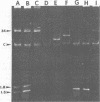Abstract
An outbreak of nosocomial infections was caused by a single strain of methicillin-resistant (MR) Staphylococcus aureus. This strain was followed as it was transmitted from the index case to 17 patients, 3 hospital personnel, and 12 items in the hospital environment. The MR S. aureus strain was traced by using four specific epidemiological markers: antibiogram, phage type, production of aminoglycoside-inactivating enzymes, and plasmid pattern. These markers were assessed for their reliability in differentiating the epidemic S. aureus strain from resident nonepidemic strains and for the ease and rapidity with which they determined differences. The epidemic strain was resistant to beta-lactam antibiotics, gentamicin, erythromycin, clindamycin, and rifampin. Resistance to rifampin was the only unique marker in the antibiogram which distinguished the epidemic strain from the indigenous strains, and it was the easiest marker to use for screening isolates from culture surveys. Phage typing was poorly reproducible and did not yield results rapidly enough to be useful for ongoing epidemiology. The epidemic strain produced a unique aminoglycoside-inactivating enzyme (3'-phosphotransferase) which distinguished it from indigenous gentamicin-resistant staphylococci, but this marker was not easily identified, nor was identification helpful during the course of the investigation. Plasmid pattern analysis was rapidly performed (in less than 24 h), allowed many isolates to be examined at a time, was stable and reproducible, and yielded a unique fingerprint which distinguished the epidemic strain from all indigenous isolates. Plasmid pattern analysis is a promising epidemiological tool for MR S. aureus outbreaks in which epidemic strains lack unique antibiotic resistance markers.
Full text
PDF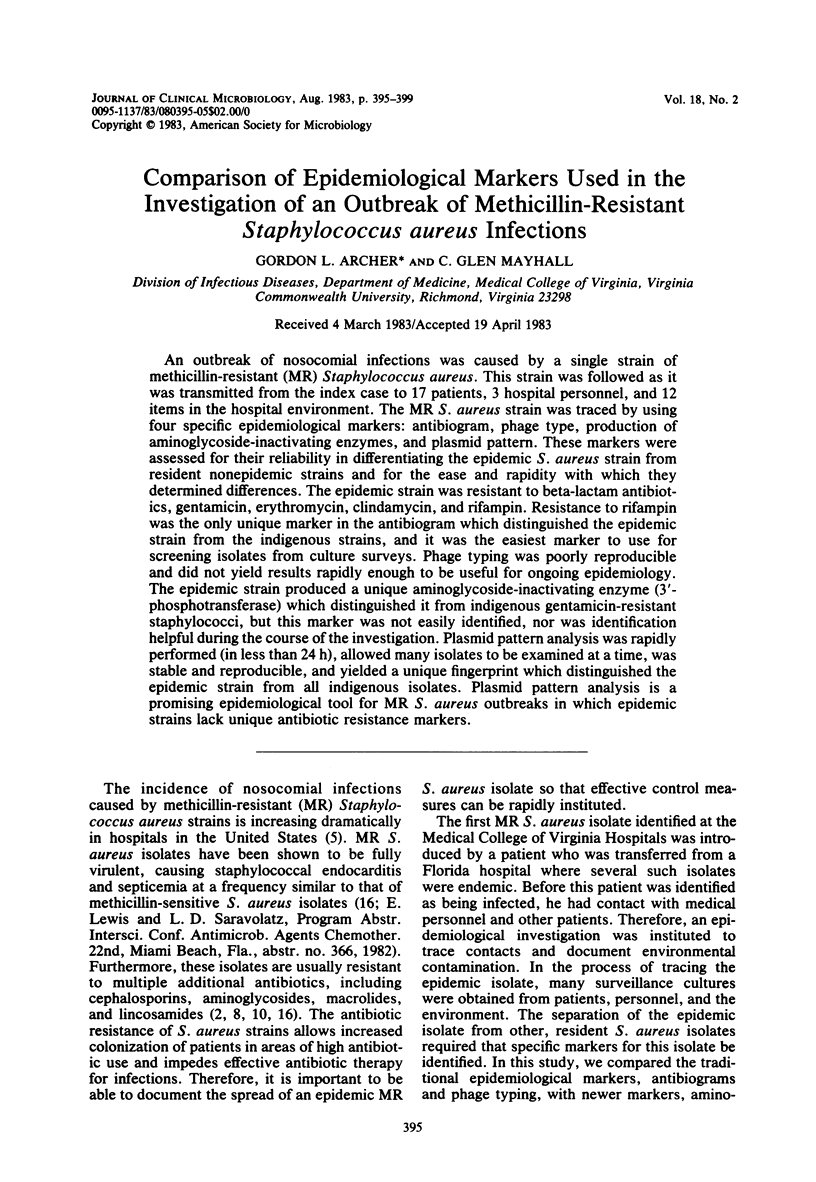
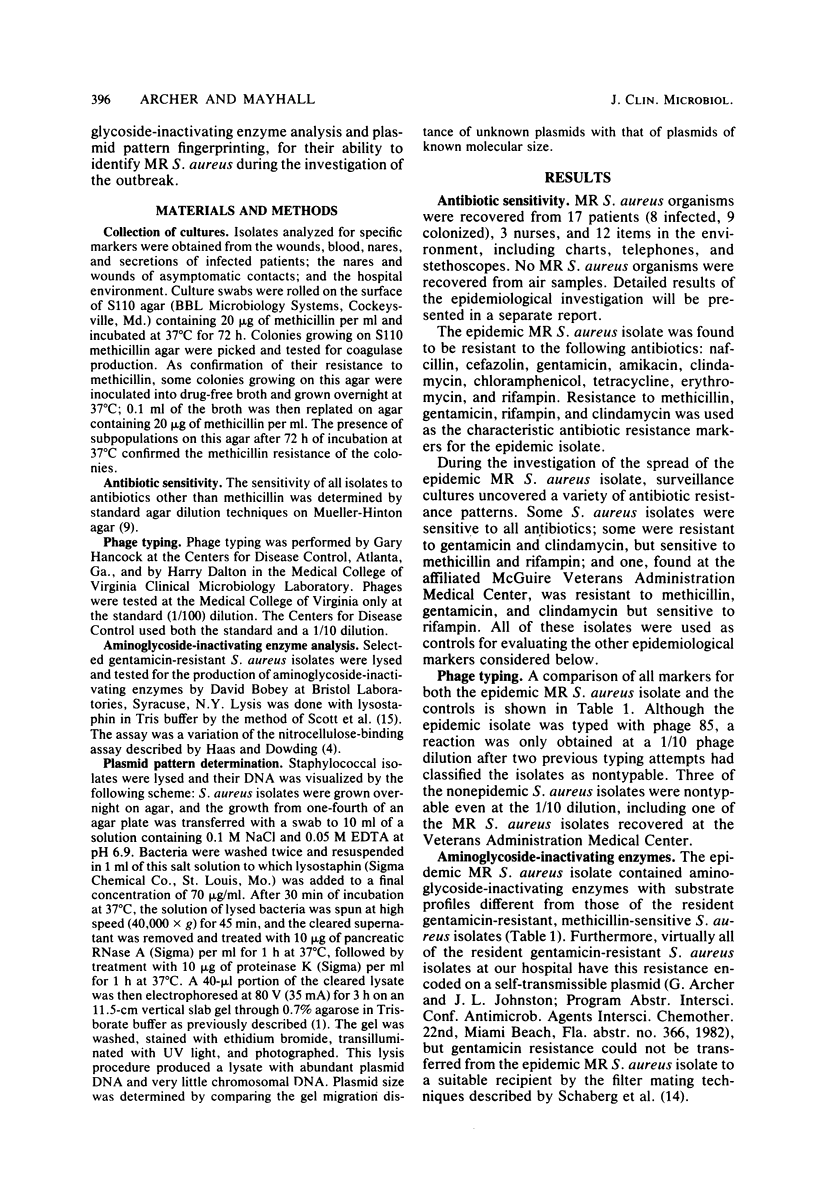
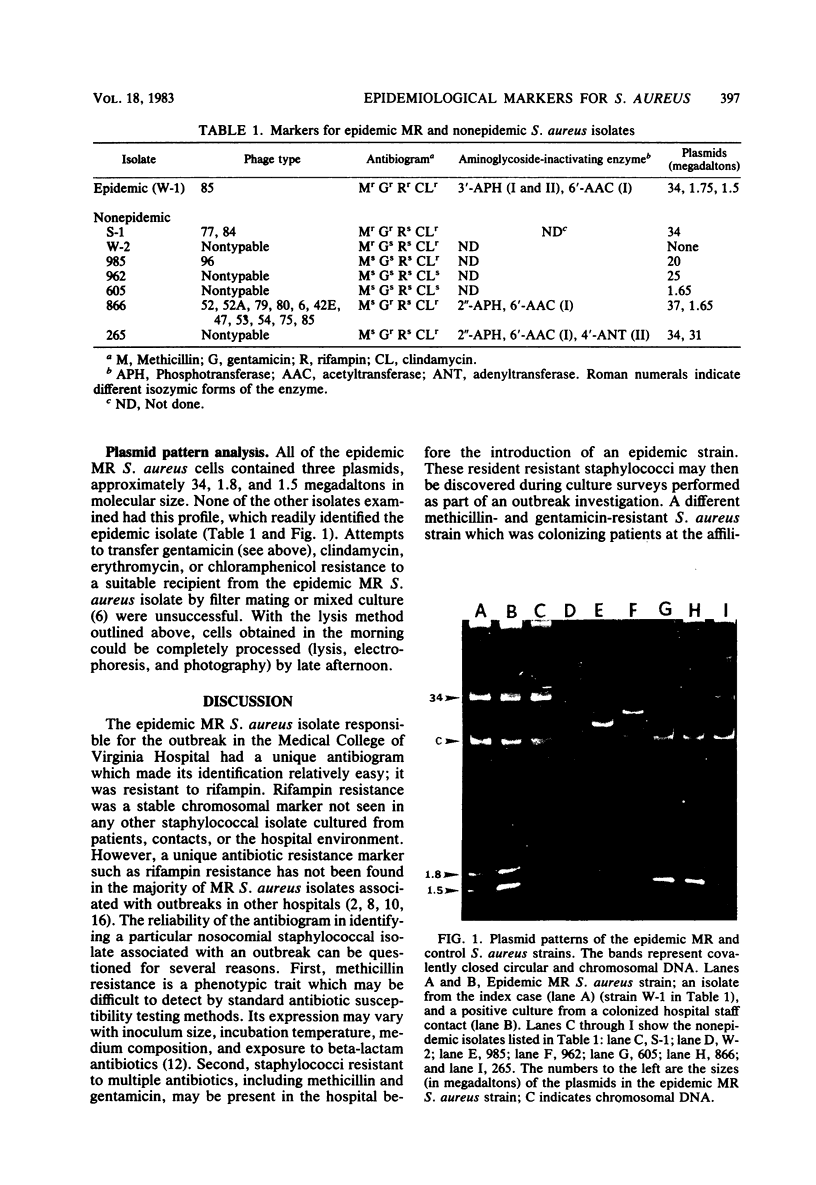
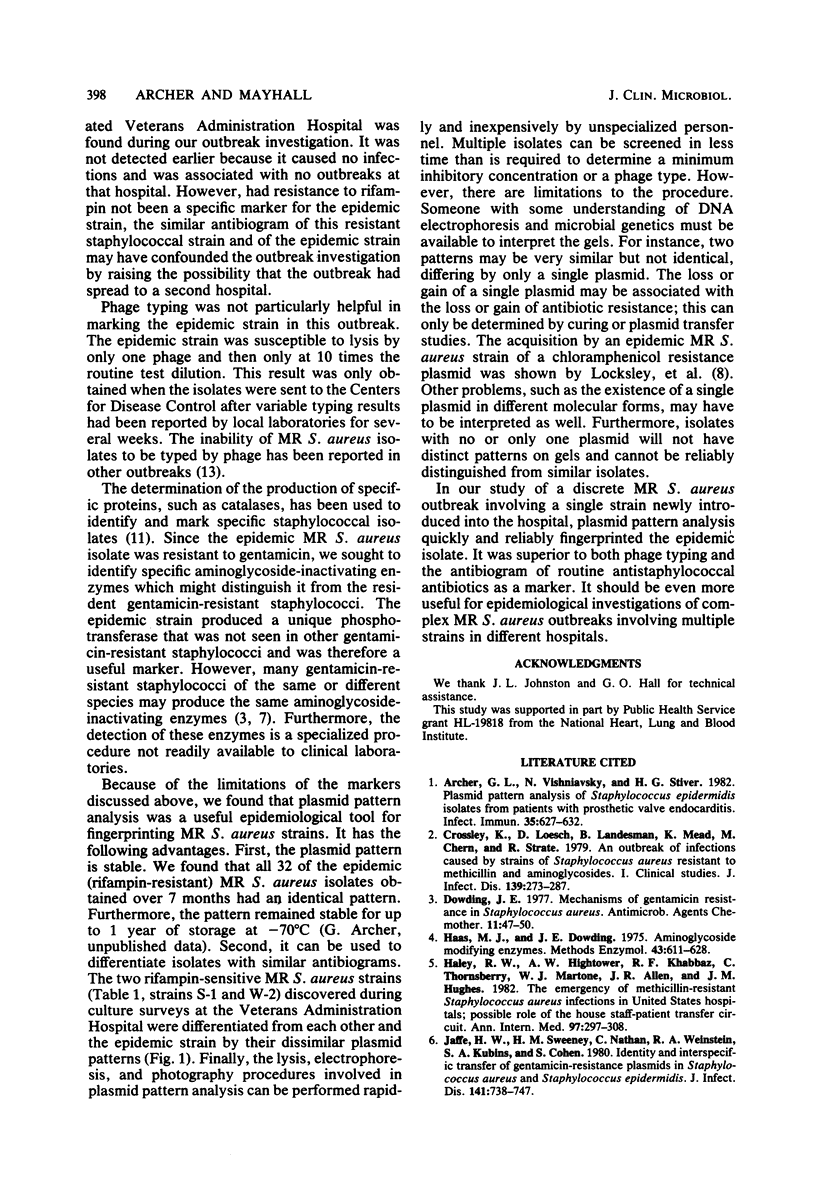
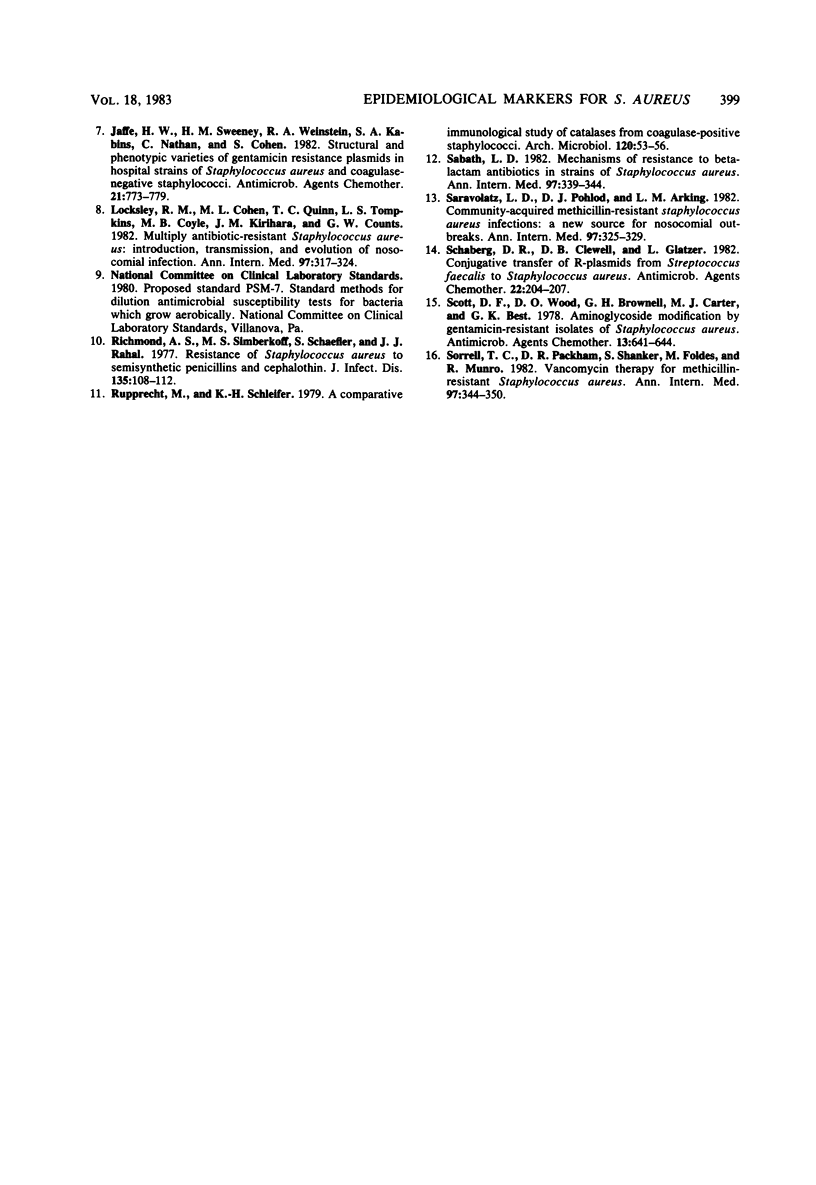
Images in this article
Selected References
These references are in PubMed. This may not be the complete list of references from this article.
- Archer G. L., Vishniavsky N., Stiver H. G. Plasmid pattern analysis of Staphylococcal epidermidis isolates from patients with prosthetic valve endocarditis. Infect Immun. 1982 Feb;35(2):627–632. doi: 10.1128/iai.35.2.627-632.1982. [DOI] [PMC free article] [PubMed] [Google Scholar]
- Crossley K., Loesch D., Landesman B., Mead K., Chern M., Strate R. An outbreak of infections caused by strains of Staphylococcus aureus resistant to methicillin and aminoglycosides. I. Clinical studies. J Infect Dis. 1979 Mar;139(3):273–279. doi: 10.1093/infdis/139.3.273. [DOI] [PubMed] [Google Scholar]
- Dowding J. E. Mechanisms of gentamicin resistance in Staphylococcus aureus. Antimicrob Agents Chemother. 1977 Jan;11(1):47–50. doi: 10.1128/aac.11.1.47. [DOI] [PMC free article] [PubMed] [Google Scholar]
- Haas M. J., Dowding J. E. Aminoglycoside-modifying enzymes. Methods Enzymol. 1975;43:611–628. doi: 10.1016/0076-6879(75)43124-x. [DOI] [PubMed] [Google Scholar]
- Haley R. W., Hightower A. W., Khabbaz R. F., Thornsberry C., Martone W. J., Allen J. R., Hughes J. M. The emergence of methicillin-resistant Staphylococcus aureus infections in United States hospitals. Possible role of the house staff-patient transfer circuit. Ann Intern Med. 1982 Sep;97(3):297–308. doi: 10.7326/0003-4819-97-3-297. [DOI] [PubMed] [Google Scholar]
- Jaffe H. W., Sweeney H. M., Nathan C., Weinstein R. A., Kabins S. A., Cohen S. Identity and interspecific transfer of gentamicin-resistance plasmids in Staphylococcus aureus and Staphylococcus epidermidis. J Infect Dis. 1980 Jun;141(6):738–747. doi: 10.1093/infdis/141.6.738. [DOI] [PubMed] [Google Scholar]
- Jaffe H. W., Sweeney H. M., Weinstein R. A., Kabins S. A., Nathan C., Cohen S. Structural and phenotypic varieties of gentamicin resistance plasmids in hospital strains of Staphylococcus aureus and coagulase-negative staphylococci. Antimicrob Agents Chemother. 1982 May;21(5):773–779. doi: 10.1128/aac.21.5.773. [DOI] [PMC free article] [PubMed] [Google Scholar]
- Locksley R. M., Cohen M. L., Quinn T. C., Tompkins L. S., Coyle M. B., Kirihara J. M., Counts G. W. Multiply antibiotic-resistant Staphylococcus aureus: introduction, transmission, and evolution of nosocomial infection. Ann Intern Med. 1982 Sep;97(3):317–324. doi: 10.7326/0003-4819-97-3-317. [DOI] [PubMed] [Google Scholar]
- Richmond A. S., Simberkoff M. S., Schaefler S., Rahal J. J., Jr Resistance of Staphylococcus aureus to semisynthetic penicillins and cephalothin. J Infect Dis. 1977 Jan;135(1):108–112. doi: 10.1093/infdis/135.1.108. [DOI] [PubMed] [Google Scholar]
- Rupprecht M., Schleifer K. H. A comparative immunological study of catalases from coagulase-positive staphylococci. Arch Microbiol. 1979 Jan 16;120(1):53–56. doi: 10.1007/BF00413273. [DOI] [PubMed] [Google Scholar]
- Sabath L. D. Mechanisms of resistance to beta-lactam antibiotics in strains of Staphylococcus aureus. Ann Intern Med. 1982 Sep;97(3):339–344. doi: 10.7326/0003-4819-97-3-339. [DOI] [PubMed] [Google Scholar]
- Saravolatz L. D., Pohlod D. J., Arking L. M. Community-acquired methicillin-resistant Staphylococcus aureus infections: a new source for nosocomial outbreaks. Ann Intern Med. 1982 Sep;97(3):325–329. doi: 10.7326/0003-4819-97-3-325. [DOI] [PubMed] [Google Scholar]
- Schaberg D. R., Clewell D. B., Glatzer L. Conjugative transfer of R-plasmids from Streptococcus faecalis to Staphylococcus aureus. Antimicrob Agents Chemother. 1982 Aug;22(2):204–207. doi: 10.1128/aac.22.2.204. [DOI] [PMC free article] [PubMed] [Google Scholar]
- Scott D. F., Wood D. O., Brownell G. H., Carter M. J., Best G. K. Aminoglycoside modification by gentamicin-resistant isolates of Staphylococcus aureus. Antimicrob Agents Chemother. 1978 Apr;13(4):641–644. doi: 10.1128/aac.13.4.641. [DOI] [PMC free article] [PubMed] [Google Scholar]
- Sorrell T. C., Packham D. R., Shanker S., Foldes M., Munro R. Vancomycin therapy for methicillin-resistant Staphylococcus aureus. Ann Intern Med. 1982 Sep;97(3):344–350. doi: 10.7326/0003-4819-97-3-344. [DOI] [PubMed] [Google Scholar]



